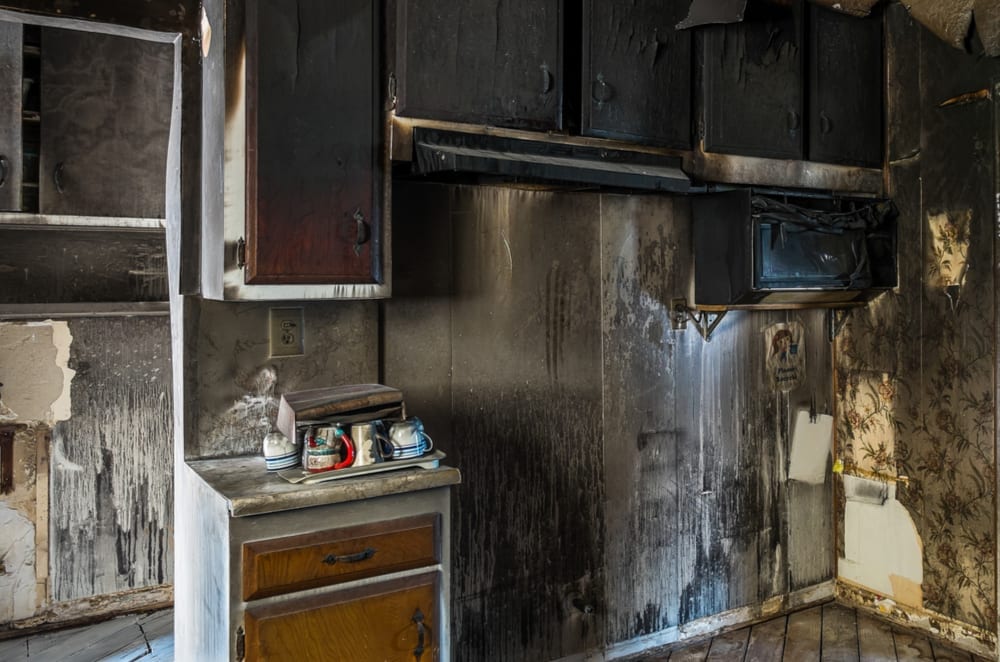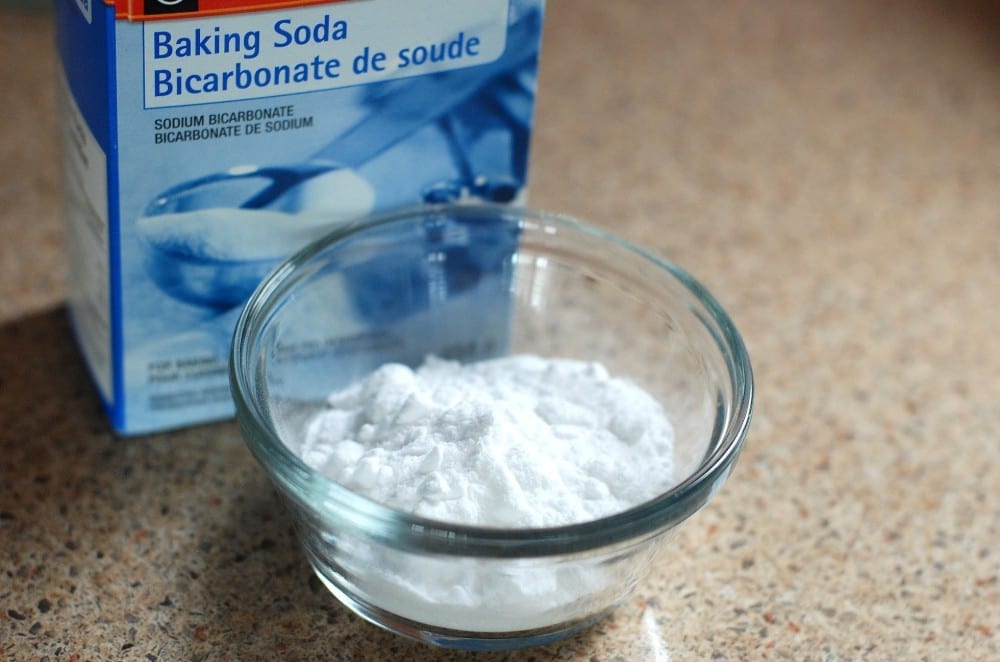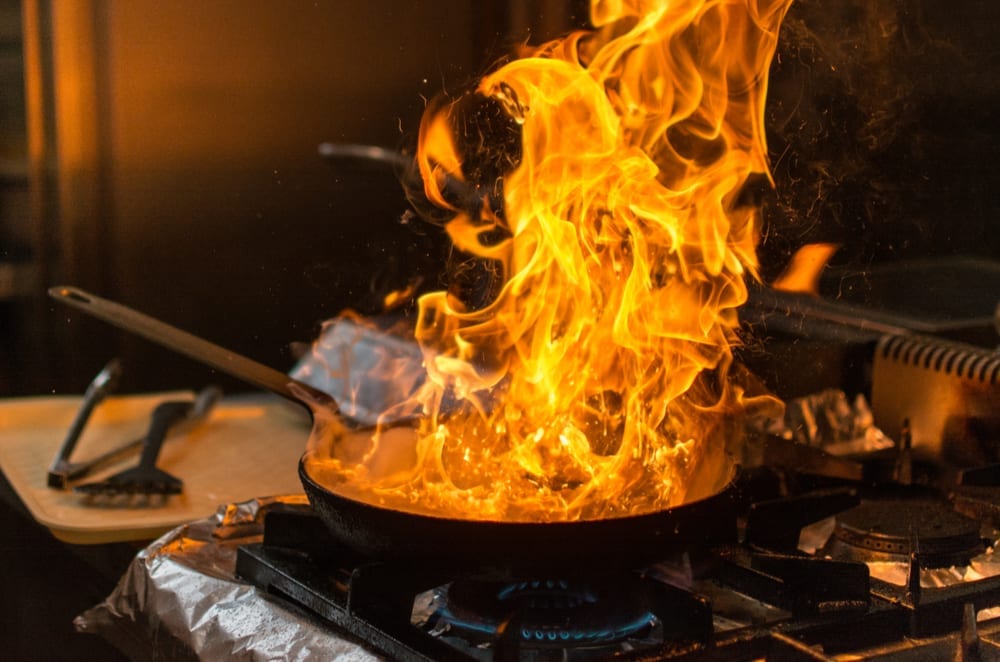Smoke and soot from a fire can leave your home both dirty and smelly. When possible, you should begin cleaning smoke stains as soon as can to prevent them from permanently setting it. In some cases, you can clean smoke stains on your own with only a few specialty cleaning items. Our cleaning smoke damage guide outlines the steps to take, the areas most common to smoke damage, and surfaces that you can clean. Plus, we review the safest, most cost-effective ways to remove smoke odors.
How to Clean Smoke Damage
Before you begin cleaning smoke stains, make sure that your property is structurally sound. A small kitchen or grease fire poses little risk, but have the area inspected by a professional if the flames burned a significant portion of your home. Also, wear protective gear when cleaning smoke damage. This includes work boots, pants, long sleeves, rubber gloves, goggles, and a ventilator.
1. Remove Damaged Materials
Remove all of the materials damaged by the flames. This includes burned items that cannot be salvaged, food that is contaminated by smoke or soot, and plastics or other materials too stained to clean.
2. Vacuum Up Soot and Debris
Then use a shop vac to suck up as much remaining debris as possible. Soot can be greasy, so avoid rubbing the end of the shop vac hose directly on surfaces. This can push stains deeper into the surface, making them harder to clean. Keep the hose tip as close to surfaces as possible without actually touching them.
3. Cleaning Smoke Stains From Hard Surfaces
Mix a trisodium phosphate cleaner, sometimes called TSP, according to the manufacturer’s instructions in a bucket. Then use rags to clean smoke-stained surfaces. Start cleaning at the top of each surface, then move across and down. This prevents drips and smears from spreading dirt to areas you have already cleaned.
After cleaning, wipe the surface with a rag soaked in clean water to rinse away the TSP solution. Avoid saturating the walls and surfaces with the cleaning solution or rinse water. Since it’s mostly water, it can both weaken the surface as well as potentially lead to a mold issue.
For extremely stained surfaces, use a dry-cleaning sponge. Also called a chemical sponge or a soot eraser, this is a rubberized sponge that you without water to clean soot and stains. It’s especially good at removing oily or greasy stains, like smoke stains after a fire.
4. Cleaning Smoke Damage From Fabric or Porous Materials
Fabric and upholstery can absorb both smoke stains and odors. Take dry-clean-only fabrics to a dry cleaner that specialized in stain removal or fire treatment. For machine-washable fabrics, allow your washing machine to fill up and then add a cup of both white vinegar and baking soda.
Allow smoke-stained fabrics to soak for an hour, then run the wash cycle as normal. Avoid drying until the stains are completely gone, as the heat can cause them to set in permanently. Once the stains are gone, dry them or hang them outside to air dry. This will also help with odor removal.
For upholstery and carpeting, spot clean with vinegar or a mixture of vinegar and baking soda. Avoid over saturating, as this can allow mold to grow over time. For stubborn stains, use a carpet cleaner with an upholstery attachment.
5. Seal Stained Surfaces
Even with a thorough cleaning, some stains and odors will linger. Use a sealing primer will encapsulate both stains and odors. Use a stain concealing primer on walls, then apply a topcoat of regular latex paint. For wood, particleboard, and other surfaces use a sealer designed for those surfaces.
If you used a solution of TSP when cleaning smoke damage, make sure you allow walls and surfaces to dry thoroughly before sealing. Fans and dehumidifiers will help speed up the process. Applying a sealant to a wet surface will only cause it to bubble and flake.

Other Tips to Cleaning Smoke Damage After a Fire
- Document Smoke Damage Before Cleanup – Understandably, you will be eager to clean smoke damage after a fire. However, always document the damage first for your insurance company. Even if you don’t think you’ll file a claim, it’s better to take photos first. This keeps you covered in case you need to file one later.
- Turn Off Your Furnace and Air Conditioner – Your heating and cooling systems will push air – and the smoke and soot in the air – throughout your home. Turn them off until you are finished removing damaged materials and debris.
- Avoid Opening Windows – While you may want to air out after a fire, avoid opening windows until after cleaning smoke stains. This will prevent spreading smoke and soot through your home.
- Replace Your Furnace Filter – If smoke and soot entered your furnace or air conditioner, it likely clogged your filter. As your heating and cooling systems run, they can spread both soot and smoke odors even months after your fire.
- Clean Vent Covers – Remove the covers on your vents and clean them to limit the amount of smoke and soot in them. Use a shop vacuum to clean the inside of the vent and the ductwork.
- Put Filters on Your Vents – Even with changing the furnace filter and cleaning your vents, it’s likely that smoke and soot are still in the ducts. Put filters on all of the vents, check them regularly, and replace them as necessary. You can stop using the filters once all of them are clean and clear for a week straight.
- Clean Your Faucet Heads – Faucets, especially kitchen sink and bathroom faucets, are easily overlooked during the cleaning process. But they actually present a flat underside where smoke and soot can settle. Wipe them clean with your cleaning solution, then allow water to run for a minute before using them.
How to Remove Smoke Odors After a Fire
In addition to cleaning smoke damage, you may also need to remove smoke odors as well. Depending on the extent of your fire damage, smoke odors may linger for weeks, months, or even years.
While ozone machines are often recommended for removing odors, they are dangerous to use. Commercial sprays or candles are much safer, but they usually just add fragrance to the smoke smell. These cost-effective methods are just as, if not more efficient at removing smoke odors.
Vinegar
Regular household white distilled vinegar is great at eliminating odors. Mix it in equal parts with water and spray a fine mist on hard surfaces. Allow it to dry naturally and repeat as necessary to remove smoke odors.
Baking Soda
Sprinkle a fine layer of baking soda on fabric, upholstery, and carpeting and gently rub in. Allow it to sit for an hour up to overnight, then vacuum it up. Reapply as necessary until the odor is gone.
Coffee Grounds
You can reuse the grounds from your morning coffee to help remove smokey smells. Put them in bowls or dishes throughout your home and change them out every day.
Charcoal
Use activated charcoal to soak up the smoke smell by putting small bowls or dishes around your home. You can break up charcoal briquettes in a pinch, but they may contain lighter fluid and other chemicals that have their own smells. Change them out for new charcoal every week.
Vanilla Extract
The strong, sweet scent of vanilla is also effective at removing smokey smells. Soak some cotton balls in vanilla extract, then put them in little cups around the house. Reapply every couple of days until the smoke odors are gone.

Areas Most Common for Smoke Damage
- Ceilings – Heat rises, bring smoke and soot with it. They will cling to the first surface they contact, which is usually your ceiling. Smoke stains are usually more severe directly above the fire.
- Underside of Surfaces – As with ceilings, the underside of any surface is more likely to have smoke stains. This includes the slight overhang of countertops, the bottom of hanging cabinets, and any item that has an exposed or partially exposed bottom.
- Corners – The corners and joints of any two surfaces are also more likely to collect smoke stains and soot. Air currents will keep smoke and soot moving throughout the area, but corners provide multiple surfaces to cling to, increasing the chances of stains.
Surfaces You Can Clean Smoke Stains From After a Fire
- Studs and Structural Beams – You can clean smoke damage from wood studs and other support beams as long as they aren’t significantly damaged by flames. If there is flame damage with char more than a quarter of an inch into the material, you should replace them to ensure the structure of your home remains sound.
- Drywall, Plaster, and Gypsum Board – The outside of most drywall or wallboards can be cleaned. If the fire or smoke occurred inside of the walls, you will need to remove and replace the entire wall surface.
- Tile – You can clean any non-plastic tile, but grout may be difficult to clean. Some restorers suggest chipping out the grout and reapplying, however, this isn’t always effective.
- Granite, Marble, or Formica Countertops – Most countertop materials can be cleaned, but laminate materials and plastics may not come completely clean. If the smoke damaged the underside of the countertop, you may need to clean and seal it to prevent it from degrading over time.
- Carpeting – You can usually remove light smoke damage from wall to wall carpeting and rugs, but heavy smoke damage is difficult to remove. You should always try removing smoke stains from carpeting, however, replacement is often necessary.
- Laminate Flooring – Some laminate flooring materials can be cleaned, but others may need to be replaced. If the smoke damage came up from below, it may get absorbed by foam or cork underneath the flooring.
- Hardwood Flooring or Surfaces – Hardwood flooring or surfaces can be cleaned. If necessary, you can sand and refinish them to remove smoke stains or odors.
- Glass Surfaces and Windows – Most glass surfaces can be cleaned, but there is a chance of permanent discoloration or staining the longer the smoke sits.
- Plastic Surfaces and Materials – Smoke will permanently stain most plastics within minutes of exposure. You should try to clean them as soon as possible, but expect to replace most plastic items.
- Insulation – Most insulation absorbs smoke odors and cannot be cleaned. However, you can try to clean foam board insulation. Always replace loose-fill insulation that is blown-in to walls or spaces.
Get Smoke Removal Services Now
If you have trouble cleaning smoke stains or don’t have the time or supplies necessary, lets the experts at Restoration Local repair the damage fast. Call 1-888-443-3110 now for a free estimate on smoke damage cleanup services. We always offer 24-hour emergency service and a 30-minute response.





